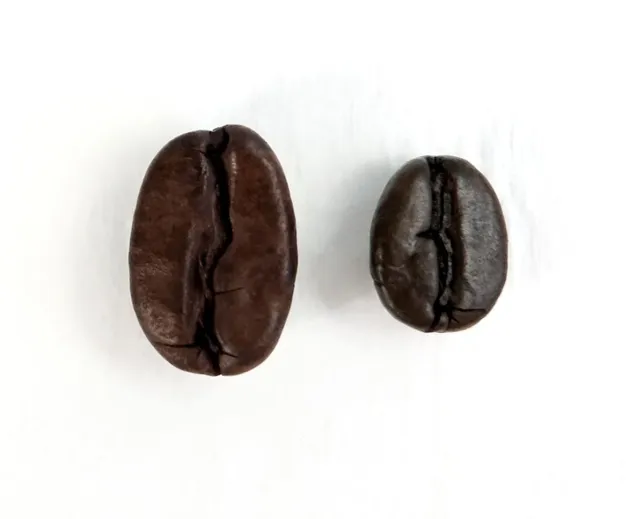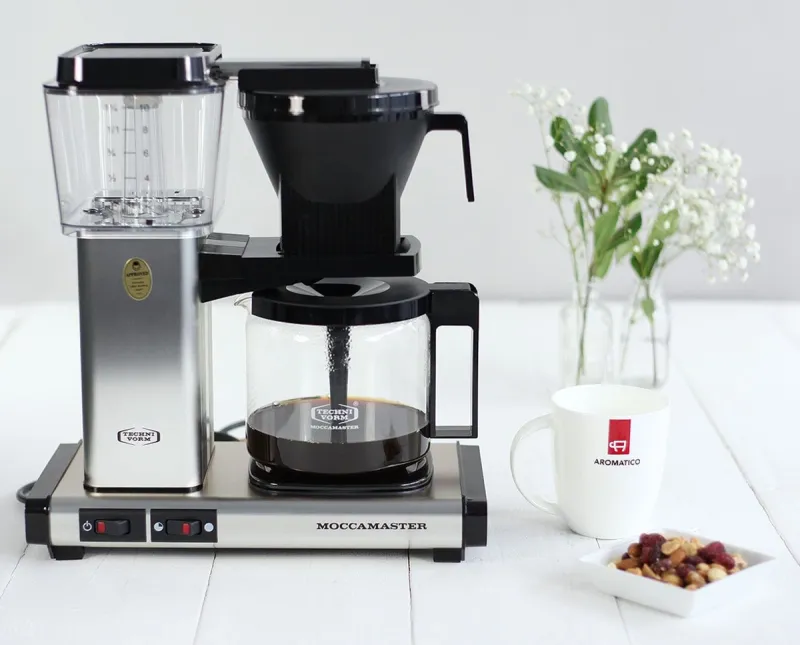Arabica and Robusta beans

On many packages, a distinction is made in terms of percentage - the information between the bean ratio of Arabica beans and Robusta beans. But why is a distinction made at all and what are the fundamental differences between the two types of beans?
Suitable coffees
What types of coffee beans actually exist?
Coffee is an agricultural product that is grown in many countries and regions, called provinces. The coffee bean is a component of the coffee cherry. Despite the given variety of growing countries and the coffees produced there, the coffee world basically distinguishes between two different varieties of coffee beans: Coffea Arabica and Coffea Canephora, respectively Arabica and Robusta beans. The Arabica and Robusta beans are often blended together to create a harmonious coffee mixture.
Different shape of coffee beans
The two types of coffee, Arabica and Canephora, differ in the shape and size of the beans alone, which even makes it possible to distinguish them with the naked eye. Robusta beans tend to be small and round coffee beans that tend to be straight. Arabica beans, on the other hand, are usually larger, have an elongated and flat shape, and have a slightly curved furrow in the longitudinal section of the bean.
Different taste arabica and robusta beans
Whether Arabica or Robusta coffee, the flavor profile of the two coffee genera is unique from each province, ensuring that the palate can always discover something new. In general, however, it can be said that Arabica beans are extremely versatile. They can develop sweet, sour, spicy and, above all, fruity aromas. Robusta beans, on the other hand, have characteristic bitter as well as chocolate notes. In addition, it provides the beloved crema in the coffee and also has a higher caffeine content than the Arabica bean. The higher the Robusta content in an espresso, the more stable and pronounced the crema is when preparing espresso with a portafilter machine. Because of these properties, Robusta beans are often integrated into espresso blends.

Oil and sugar content of coffee beans
The oil content of a coffee bean also determines the intensity of the aroma and consequently the quality of the coffee. Arabica beans contain about 50% more coffee oils than Robusta beans. While Robusta beans have an oil content of 10 - 12%, Arabica beans have an oil content of 15 - 17%. In terms of sugar content, the Arabica bean also has the higher proportion: The sugar content of Arabica beans is 6 - 9%, while the sugar content of Robusta beans is only 3 - 7%.

Coffee bean growing countries
The growing countries of both coffee bean varieties are located in the so-called coffee belt, but they prefer different growing conditions. For example, the Arabica bean coffee plant is comparatively sensitive to extreme climatic conditions and prefers a higher growing altitude. This is why it grows more in South and Central America and parts of Africa. In comparison, the Robusta bean plant is somewhat more adaptable to different weather conditions and temperatures. In contrast to the Arabica coffee bean, it prefers a warmer climate and can also thrive in lower-lying regions. For optimal cultivation, a higher altitude is therefore not quite as important as for the Arabica bean, which usually grows at an altitude of several hundred meters. Suitable cultivation areas for the Robusta bean are, for example, Asia, India and some parts of Africa.
Varying caffeine content of coffee beans
Caffeine is a naturally occurring pesticide. With a higher caffeine content, plants in nature are less susceptible to pests. Robusta coffee bean plants, among others, benefit from this advantage. The caffeine content of Robusta is double to triple that of Arabica. While the caffeine content of Arabica is only 0.8 - 1.4%, the caffeine content of Robusta is a full 1.7 - 4.0%. Thus, the Robusta bean is the more potent stimulant with more caffeine.
Which bean is better?
Basically, neither coffee bean type is better or worse than the other. Although "100% Arabica" is often advertised, this does not immediately guarantee better quality. When making a personal choice of coffee type, decisions should be made based on personal taste and preferred characteristics. By extensively tasting different types of coffee, you are guaranteed to find your personal favorite.
Trade and exchange of coffee beans
Like many other agricultural products, coffee is also traded on a commodity exchange. However, here the coffee varieties differ considerably. Arabica beans account for 60% of the world's coffee production and are now mainly traded on the New York Commodity Exchange (ICE Futures U.S.) in "lots" (17,010 kg). Robusta, unlike Arabica, is sold, or rather bought, on the London Stock Exchange (the NYSE Euronext Liffe) - and also in a smaller unit (10,000 kg per lot).

Conclusion
The difference between Arabica and Robusta coffee beans lies in many characteristics of the beans. The shape is the biggest visual difference. In addition to different growing countries, the two best-known bean varieties also differ in properties such as taste, oil and sugar content or caffeine content.










